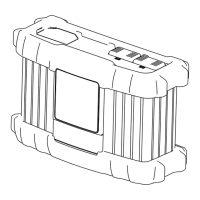WARNING!
Danger due to the use of the incorrect type of battery and incorrect charge set-
tings.
This can result in serious injury and damage to property.
▶
Before starting the charging process, make sure that the correct type of bat-
tery is set on the charger.
▶
The following settings must be performed for the individual types of batter-
ies before charging:
Charging curve
Nominal voltage (number of battery cells)
Battery capacity (Ah) or charging time (h)
More information on the charger parameters can be found under "Configuration
mode" in the "Display" chapter.
NOTE!
Risk of property damage if the charging plug contacts are very dirty.
The resulting increase in contact resistance can lead to overheating and sub-
sequent destruction of the charging plug.
▶
Keep the charging plug contacts free from impurities and clean them if ne-
cessary.
1
Connect the charger mains plug to the electrical mains supply.
You will be prompted to confirm whether the correct parameters have been set
for the battery to be charged.
The display then appears in standard
mode. The display shows the charger
parameters:
-
Type of battery (e.g. Pb-WET)
-
Charging characteristic (e.g. IUI)
-
Nominal voltage (e.g. 48 V)
-
Capacity (e.g. 300 Ah)
-
Day of the week, date and time
The charger parameters can be set individually. More information on the charger
parameters can be found under "Configuration mode" in the "Display" chapter.
Ensure that the battery to be charged matches the configuration of the charger.
2
Plug in the charging plug.
The charger detects that the battery is connected and starts charging. If start-up
delay is activated, charging will start at the end of the set delay time. For more
information, see "Configuration mode" in the "Display" chapter.
During the charging process the display shows the following values:
-
Current charging current (A)
-
Current charging voltage (V)
-
Applied charge (Ah)
-
Battery temperature with the "temperature-controlled charging" option
-
Time (hh:mm) since charging started
27
EN

